中国古代四大发明中英文版剖析
- 格式:ppt
- 大小:1.16 MB
- 文档页数:15
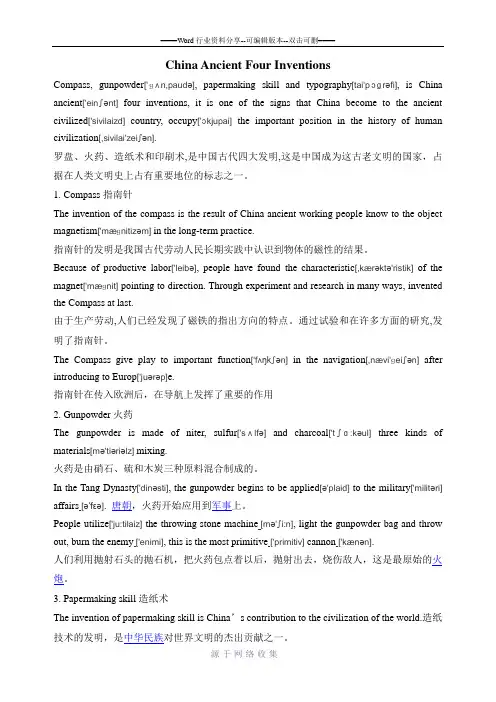
China Ancient Four InventionsCompass, gunpowder['ɡʌn,paudə], papermaking skill and typography[tai'pɔɡrəfi], is China ancient['einʃənt]four inventions, it is one of the signs that China become to the ancient civilized['sivilaizd]country, occupy['ɔkjupai]the important position in the history of human civilization[,sivilai'zeiʃən].罗盘、火药、造纸术和印刷术,是中国古代四大发明,这是中国成为这古老文明的国家,占据在人类文明史上占有重要地位的标志之一。
1. Compass指南针The invention of the compass is the result of China ancient working people know to the object magnetism['mæɡnitizəm] in the long-term practice.指南针的发明是我国古代劳动人民长期实践中认识到物体的磁性的结果。
Because of productive labor['leibə], people have found the characteristic[,kærəktə'ristik]of the magnet['mæɡnit] pointing to direction. Through experiment and research in many ways, invented the Compass at last.由于生产劳动,人们已经发现了磁铁的指出方向的特点。
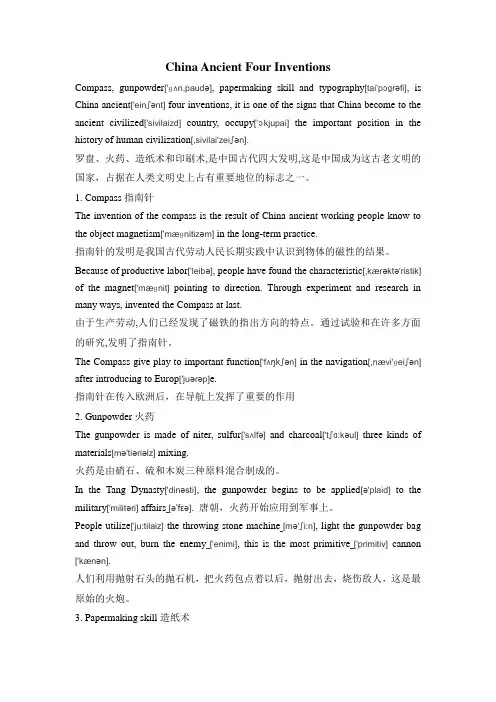
China Ancient Four InventionsCompass, gunpowder['ɡʌn,paudə], papermaking skill and typography[tai'pɔɡrəfi], is China ancient['einʃənt] four inventions, it is one of the signs that China become to the ancient civilized['sivilaizd]country, occupy['ɔkjupai]the important position in the history of human civilization[,sivilai'zeiʃən].罗盘、火药、造纸术和印刷术,是中国古代四大发明,这是中国成为这古老文明的国家,占据在人类文明史上占有重要地位的标志之一。
1. Compass指南针The invention of the compass is the result of China ancient working people know to the object magnetism['mæɡnitizəm] in the long-term practice.指南针的发明是我国古代劳动人民长期实践中认识到物体的磁性的结果。
Because of productive labor['leibə], people have found the characteristic[,kærəktə'ristik] of the magnet['mæɡnit]pointing to direction. Through experiment and research in many ways, invented the Compass at last.由于生产劳动,人们已经发现了磁铁的指出方向的特点。
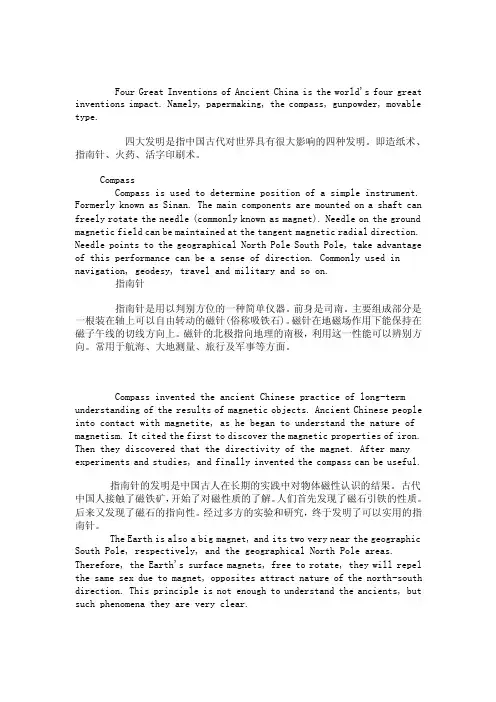
Four Great Inventions of Ancient China is the world's four great inventions impact. Namely, papermaking, the compass, gunpowder, movable type.四大发明是指中国古代对世界具有很大影响的四种发明。
即造纸术、指南针、火药、活字印刷术。
CompassCompass is used to determine position of a simple instrument. Formerly known as Sinan. The main components are mounted on a shaft can freely rotate the needle (commonly known as magnet). Needle on the ground magnetic field can be maintained at the tangent magnetic radial direction. Needle points to the geographical North Pole South Pole, take advantage of this performance can be a sense of direction. Commonly used in navigation, geodesy, travel and military and so on.指南针指南针是用以判别方位的一种简单仪器。
前身是司南。
主要组成部分是一根装在轴上可以自由转动的磁针(俗称吸铁石)。
磁针在地磁场作用下能保持在磁子午线的切线方向上。
磁针的北极指向地理的南极,利用这一性能可以辨别方向。
常用于航海、大地测量、旅行及军事等方面。
Compass invented the ancient Chinese practice of long-term understanding of the results of magnetic objects. Ancient Chinese people into contact with magnetite, as he began to understand the nature of magnetism. It cited the first to discover the magnetic properties of iron. Then they discovered that the directivity of the magnet. After many experiments and studies, and finally invented the compass can be useful.指南针的发明是中国古人在长期的实践中对物体磁性认识的结果。
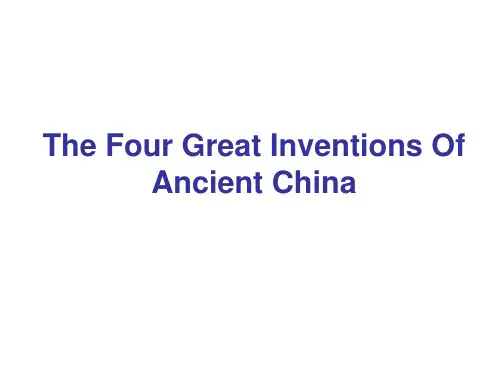
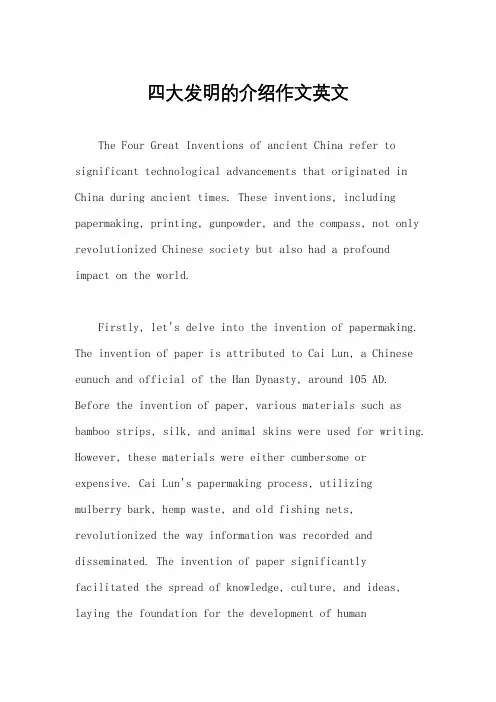
四大发明的介绍作文英文The Four Great Inventions of ancient China refer to significant technological advancements that originated in China during ancient times. These inventions, including papermaking, printing, gunpowder, and the compass, not only revolutionized Chinese society but also had a profound impact on the world.Firstly, let's delve into the invention of papermaking. The invention of paper is attributed to Cai Lun, a Chinese eunuch and official of the Han Dynasty, around 105 AD. Before the invention of paper, various materials such as bamboo strips, silk, and animal skins were used for writing. However, these materials were either cumbersome or expensive. Cai Lun's papermaking process, utilizingmulberry bark, hemp waste, and old fishing nets, revolutionized the way information was recorded and disseminated. The invention of paper significantlyfacilitated the spread of knowledge, culture, and ideas, laying the foundation for the development of humancivilization.Next, printing, another remarkable invention, greatly accelerated the dissemination of knowledge. The invention of woodblock printing is attributed to Bi Sheng during the Northern Song Dynasty in the 11th century. This technique involved carving characters onto wooden blocks, which were then inked and pressed onto paper to produce multiple copies of texts. Woodblock printing enabled the mass production of books, making literature more accessible to the general population. Later, the invention of movable type printing by Bi Sheng's successor, Wang Zhen, further revolutionized the printing industry. Movable type allowed for more efficient printing and contributed to the proliferation of literature, science, and culture.Gunpowder, one of the most influential inventions in human history, was discovered accidentally by Chinese alchemists during the Tang Dynasty (9th century AD). Initially used for medicinal purposes, gunpowder's explosive properties were soon recognized and harnessed for military applications. The development of gunpowderweaponry, such as cannons, firearms, and rockets, transformed the nature of warfare and had a profound impact on geopolitics. Gunpowder technology eventually spread to other parts of the world, leading to significant changes in military tactics and strategies.Lastly, the compass, another pivotal invention, revolutionized navigation and exploration. While the exact origins of the compass remain debated, it became widely used in China during the Song Dynasty (11th century AD). The compass, initially a simple lodestone compass, provided sailors with a reliable means of determining direction at sea. This technological advancement facilitated maritime trade, exploration, and the spread of ideas and cultures across continents. The compass played a crucial role in enabling the Age of Exploration and the subsequent globalization of trade and communication.In conclusion, the Four Great Inventions of ancient China—papermaking, printing, gunpowder, and the compass—ushered in significant advancements in human civilization. These inventions not only transformed Chinese society butalso had far-reaching impacts on global history, culture, and technology. Their legacies continue to shape the modern world, serving as a testament to the ingenuity andcreativity of ancient Chinese civilization.。
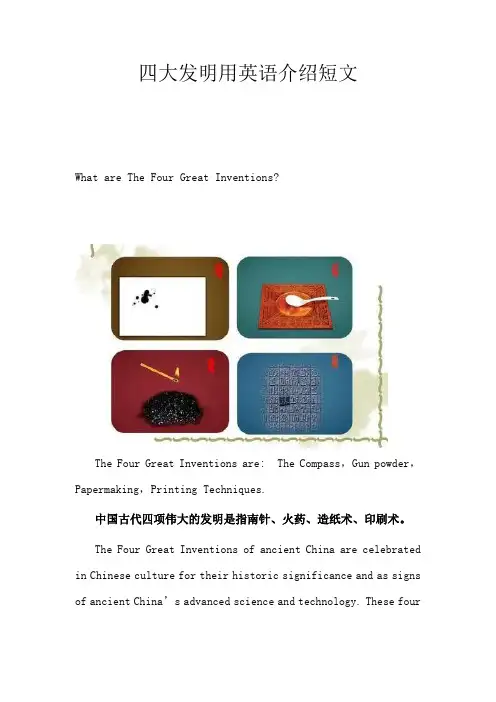
四大发明用英语介绍短文What are The Four Great Inventions?The Four Great Inventions are: The Compass,Gun powder,Papermaking,Printing Techniques.中国古代四项伟大的发明是指南针、火药、造纸术、印刷术。
The Four Great Inventions of ancient China are celebrated in Chinese culture for their historic significance and as signs of ancient China’s advanced science and technology. These fourinventions greatly promoted the development of China’s economy, politics, and culture.中国古代的四大发明因其历史意义和作为中国古代先进科学技术的标志而在中国文化中受到赞扬。
这四大发明大大促进了中国经济、政治和文化的发展。
The CompassThe history of the compass can be dated back tothe Warring States Period (476–221 BC), when Chinese people used a device calledsi nan to point the direction.指南针的历史可以追溯到战国时期(公元前476-221年),当时中国人使用一种叫做司南的装置来指明方向。
After constant improvement, a round compass with a tiny needle made of magnetized steel were invented during the early Song Dynasty. One end of the tiny needle points to the south and the other points to the north. The compass was then introduced to the Arab world and Europe during the Northern Song era (960–1127).经过不断的改进,在宋朝初期发明了一种带有磁化钢制成的小针的圆形罗盘。
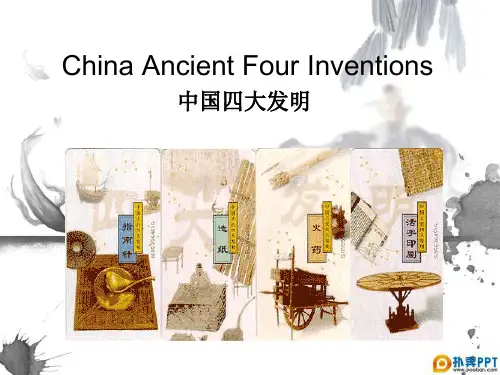
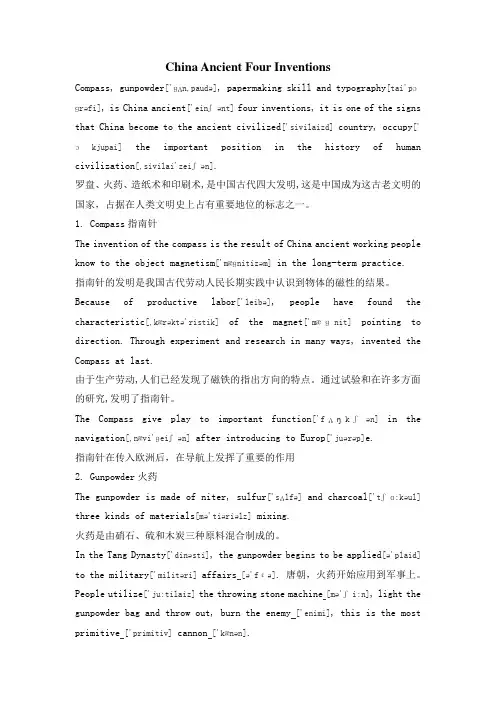
China Ancient Four InventionsCompass, gunpowder['ɡʌn,paudə], papermaking skill and typography[tai'pɔɡrəfi], is China ancient['einʃənt]four inventions, it is one of the signs that China become to the ancient civilized['sivilaizd] country, occupy['ɔkjupai]the important position in the history of human civilization[,sivilai'zeiʃən].罗盘、火药、造纸术和印刷术,是中国古代四大发明,这是中国成为这古老文明的国家,占据在人类文明史上占有重要地位的标志之一。
1. Compass指南针The invention of the compass is the result of China ancient working people know to the object magnetism['mæɡnitizəm] in the long-term practice.指南针的发明是我国古代劳动人民长期实践中认识到物体的磁性的结果。
Because of productive labor['leibə], people have found the characteristic[,kærəktə'ristik]of the magnet['mæɡnit]pointing to direction. Through experiment and research in many ways, invented the Compass at last.由于生产劳动,人们已经发现了磁铁的指出方向的特点。
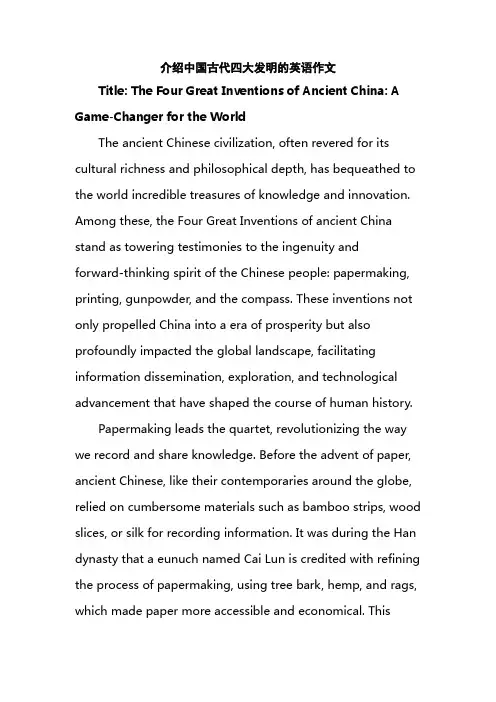
介绍中国古代四大发明的英语作文Title: The Four Great Inventions of Ancient China: A Game-Changer for the WorldThe ancient Chinese civilization, often revered for its cultural richness and philosophical depth, has bequeathed to the world incredible treasures of knowledge and innovation. Among these, the Four Great Inventions of ancient China stand as towering testimonies to the ingenuity andforward-thinking spirit of the Chinese people: papermaking, printing, gunpowder, and the compass. These inventions not only propelled China into a era of prosperity but also profoundly impacted the global landscape, facilitating information dissemination, exploration, and technological advancement that have shaped the course of human history.Papermaking leads the quartet, revolutionizing the way we record and share knowledge. Before the advent of paper, ancient Chinese, like their contemporaries around the globe, relied on cumbersome materials such as bamboo strips, wood slices, or silk for recording information. It was during the Han dynasty that a eunuch named Cai Lun is credited with refining the process of papermaking, using tree bark, hemp, and rags, which made paper more accessible and economical. Thisinvention sprouted wings for literacy and scholarship, as books became more portable and less expensive, bridging the chasm between the elite and the common folk in terms of access to knowledge.Following closely is the invention of printing, which catapulted the distribution of knowledge into a new era. Historical records attribute the development of woodblock printing to Buddhist monks during the Tang dynasty, who sought to reproduce sutras and distribute them widely among devotees. The method involved carving characters onto blocks of wood, inking them, and pressing them onto papers. By the Song dynasty, this evolved into moveable type printing, a technique that could produce books more efficiently and with greater flexibility. As a result, literature, science, and philosophy proliferated across China and, eventually, the world, democratizing education and fostering intellectual exchange.Gunpowder, while initially developed for medicinal purposes during the ninth century, soon found its more momentous use in warfare. By the 11th century, rockets, bombs, and other explosive weapons were transforming the battlefield, ushering in a new age of military technology.Although its use brought about significant changes to warfare and had profound implications for the balance of power, it also inadvertently spurred further technological advances in metallurgy and chemistry that benefitted civilian life.Last but not least, the invention of the compass reoriented the very concept of exploration. The earliest forms of the compass appeared during the Han dynasty, originally a simple spoon-shaped piece of lodestone that always pointed south. Mariners gradually adopted this tool for navigation, enabling them to venture into the vast oceans with confidence. The compass radically improved maritime travel and trade, connecting distant lands and cultures in a way hitherto unknown, laying the groundwork for the Age of Discovery.In conclusion, the Four Great Inventions of ancient China - papermaking, printing, gunpowder, and the compass - form the quartets that orchestrated a symphony of progress and connectivity across the globe. They are not merely Chinese achievements; they are milestones of universal significance, marking key transitions in human communication, learning, conflict, and exploration. These innovations laid the foundation upon which the modern world was built, proving that in the realm of knowledge and discovery, thecontributions of ancient China resonate as deeply and globally as the most powerful epic poetry.。
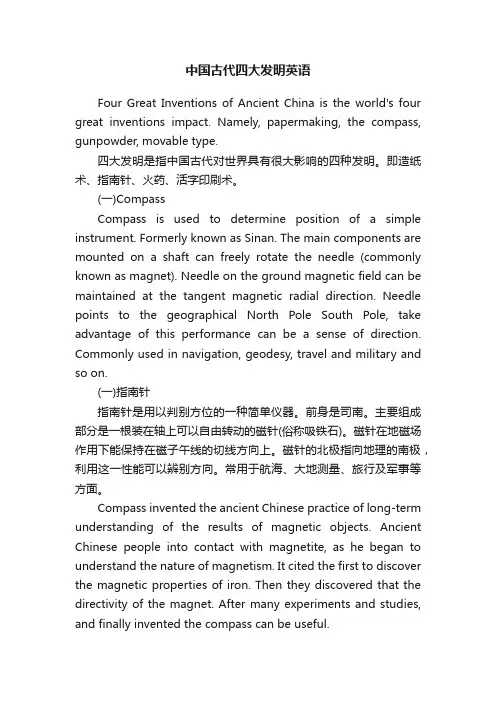
中国古代四大发明英语Four Great Inventions of Ancient China is the world's four great inventions impact. Namely, papermaking, the compass, gunpowder, movable type.四大发明是指中国古代对世界具有很大影响的四种发明。
即造纸术、指南针、火药、活字印刷术。
(一)CompassCompass is used to determine position of a simple instrument. Formerly known as Sinan. The main components are mounted on a shaft can freely rotate the needle (commonly known as magnet). Needle on the ground magnetic field can be maintained at the tangent magnetic radial direction. Needle points to the geographical North Pole South Pole, take advantage of this performance can be a sense of direction. Commonly used in navigation, geodesy, travel and military and so on.(一)指南针指南针是用以判别方位的一种简单仪器。
前身是司南。
主要组成部分是一根装在轴上可以自由转动的磁针(俗称吸铁石)。
磁针在地磁场作用下能保持在磁子午线的切线方向上。
磁针的北极指向地理的南极,利用这一性能可以辨别方向。
常用于航海、大地测量、旅行及军事等方面。
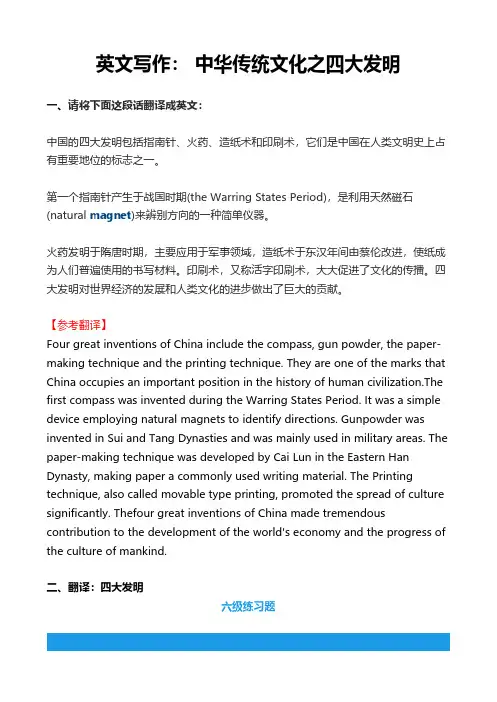
英文写作: 中华传统文化之四大发明一、请将下面这段话翻译成英文:中国的四大发明包括指南针、火药、造纸术和印刷术,它们是中国在人类文明史上占有重要地位的标志之一。
第一个指南针产生于战国时期(the Warring States Period),是利用天然磁石(natural magnet)来辨别方向的一种简单仪器。
火药发明于隋唐时期,主要应用于军事领域,造纸术于东汉年间由蔡伦改进,使纸成为人们普遍使用的书写材料。
印刷术,又称活字印刷术,大大促进了文化的传播。
四大发明对世界经济的发展和人类文化的进步做出了巨大的贡献。
【参考翻译】Four great inventions of China include the compass, gun powder, the paper-making technique and the printing technique. They are one of the marks that China occupies an important position in the history of human civilization.The first compass was invented during the Warring States Period. It was a simple device employing natural magnets to identify directions. Gunpowder was invented in Sui and Tang Dynasties and was mainly used in military areas. The paper-making technique was developed by Cai Lun in the Eastern Han Dynasty, making paper a commonly used writing material. The Printing technique, also called movable type printing, promoted the spread of culture significantly. Thefour great inventions of China made tremendous contribution to the development of the world's economy and the progress of the culture of mankind.二、翻译:四大发明六级练习题(2013年12月卷四)中国以引进新的方式方法来改变人类的生活而著称。
值得收藏!用英语介绍中国四大发明,中国四大发明用英语怎么说?我们都知道中国有四大发明,分别是“火药”、“指南针”、“造纸术”和“印刷术”,这四大发明是我们的骄傲;我们跟外国的朋友介绍的时候会经常提到,那么四大发明用英文该怎么表达呢?火药 Gunpowder简介一种黑色或棕色的炸药,由硝酸钾、木炭和硫磺机械混合而成,最初均制成粉末状,以后一般制成大小不同的颗粒状,可供不同用途之需,在采用无烟火药以前,一直用作唯一的军用发射药指南针 Compass简介指南针是一种判别方位的简单仪器,又称指北针。
指南针的前身是中国古代四大发明之一的司南。
主要组成部分是一根装在轴上可以自由转动的磁针,磁针在地磁场作用下能保持在磁子午线的切线方向上,磁针的北极指向地理的北极,利用这一性能可以辨别方向。
常用于航海、大地测量、旅行及军事等方面。
造纸术 Papermaking technique简介造纸术是中国四大发明之一,人类文明史上的一项杰出的发明创造。
中国是世界上最早养蚕织丝的国家。
汉族劳动人民以上等蚕茧抽丝织绸,剩下的恶茧、病茧等则用漂絮法制取丝绵。
漂絮完毕,篾席上会遗留一些残絮。
当漂絮的次数多了,篾席上的残絮便积成一层纤维薄片,经晾干之后剥离下来,可用于书写。
这种漂絮的副产物数量不多,在古书上称它为赫蹏或方絮。
这表明了中国汉族造纸术的起源同丝絮有着渊源关系。
活字印刷术 Movable type printing简介活字印刷术是一种古代印刷方法。
是中国古代汉族劳动人民经过长期实践和研究才发明的。
先制成单字的阳文反文字模,然后按照稿件把单字挑选出来,排列在字盘内,涂墨印刷,印完后再将字模拆出,留待下次排印时再次使用。
活字印刷术的发明是印刷史上一次伟大的技术革命。
北宋庆历间(1041-1048)中国的毕升(约970年—1051年)发明的泥活字标志活字印刷术的诞生。
他是世界上第一个发明人,比德国J.谷登堡活字印术早约400年。
Four Great Inventions of Ancient China is the world's four great inventions impact. Namely, papermaking, the compass, gunpowder, movable type.四大发明是指中国古代对世界具有很大影响的四种发明。
即造纸术、指南针、火药、活字印刷术。
(一)CompassCompass is used to determine position of a simple instrument. Formerly known as Sinan. The main components are mounted on a shaft can freely rotate the needle (commonly known as magnet). Needle on the ground magnetic field can be maintained at the tangent magnetic radial direction. Needle points to the geographical North Pole South Pole, take advantage of this performance can be a sense of direction. Commonly used in navigation, geodesy, travel and military and so on.(一)指南针指南针是用以判别方位的一种简单仪器。
前身是司南。
主要组成部分是一根装在轴上可以自由转动的磁针(俗称吸铁石)。
磁针在地磁场作用下能保持在磁子午线的切线方向上。
磁针的北极指向地理的南极,利用这一性能可以辨别方向。
常用于航海、大地测量、旅行及军事等方面。
Compass invented the ancient Chinese practice of long-term understanding of the results of magnetic objects. Ancient Chinese people into contact with magnetite, as he began to understand the nature of magnetism. It cited the first to discover the magnetic properties of iron. Then they discovered that the directivity of the magnet. After many experiments and studies, and finally invented the compass can be useful.指南针的发明是中国古人在长期的实践中对物体磁性认识的结果。
四大发明讲解词范文(中英文版)Section 1: IntroductionHello everyone, today I"m going to talk about the Four Great Inventions of ancient China.These inventions have had a significant impact on the world and are still influential today.大家好,今天我要讲的是中国古代的四大发明。
这些发明对世界产生了重大影响,至今仍在发挥其作用。
Section 2: PapermakingThe first great invention is papermaking.Before papermaking was invented in China during the Eastern Han Dynasty, people used materials like bamboo strips and silk to record information.These materials were expensive and not very practical.第一种是造纸术。
在东汉时期中国发明造纸术之前,人们使用像竹片和丝绸这样的材料来记录信息。
这些材料既昂贵又不实用。
Section 3: PrintingThe second great invention is printing.The movable type printing invented by Bi Sheng during the Song Dynasty revolutionized the way information was disseminated.This innovation made it possible to produce books on a large scale, which in turn facilitated the spread of knowledge and ideas.第二种是印刷术。
The Four Great Inventions(1)四大发明(1)During the Song Dynasty,the Chinese people furtherdeveloped the making of the compass,paper,gunpowder,and the art of printing.宋朝时期,中国人进一步发展了指南针、造纸术、火药和印刷术。
Together,they are called the four great inventionsthat China contributed to the world.这些被称为“四大发明”,是中国对世界作出的贡献。
As early as the Warring States period the magnetic force of magnetite was discovered,and asort of instrument was made of magnetite to show directions.早在战国时期,人们就发现了磁力,并用磁石制造了一种仪器,用它来辨别方向。
This was certainly the earliest compass in the world.这无疑是世界上最早的指南针。
During the Han Dynasty,people made a spoon-like compass.汉朝时期,人们制造了一种形如勺子的指南针。
A small spoon,made of magnetite,with a very smooth bottom,was placed on a square copperplate.这是一个磁石制的勺子,勺子底很平滑,置于一个四方形的铜盘上。
The center of the plate was ground smooth to make it easy for the spoon to move.盘子中心很光滑,因此勺子可以很容易地转动。
向外国笔友介绍中国古代四大发明的英语作文Dear Pen Pal,I am thrilled to share with you a fascinating aspect of Chinese history - the Four Great Inventions of ancient China. These inventions, namely papermaking, printing, the compass, and fireworks, have significantly influenced the course of civilization and technology worldwide.Let's start with papermaking. In ancient China, paper was first invented during the Han Dynasty, revolutionizing the way information was recorded and disseminated. Prior to this, bamboo slips and silk were the primary mediums for writing, but they were expensive and cumbersome. The invention of paper made knowledge more accessible and affordable, paving the way for the development of literature, science, and philosophy.Moving on to printing, the invention of the movable type printing press in the Song Dynasty marked asignificant milestone. This technology allowed for the mass production of books and other printed materials, greatlyenhancing the spread of knowledge and culture. It not only made books more widely available but also contributed tothe rise of literacy and education.The compass, another one of the Four Great Inventions, revolutionized navigation and exploration. Its origins date back to the Han Dynasty, when it was primarily used for divination purposes. However, over time, it evolved into a navigational tool that enabled sailors to determine directions accurately, leading to increased maritime trade and the discovery of new lands.Lastly, we come to fireworks. Although often associated with celebrations and festivals, fireworks originallyserved a practical purpose in ancient China. They were initially used as signals during military campaigns andlater evolved into elaborate displays for special occasions. The beauty and excitement of fireworks have captured the imagination of people worldwide, making them a universal symbol of joy and celebration.The Four Great Inventions of ancient China are not only testimonies to the ingenuity and wisdom of the Chinese people but also significant contributions to globalcivilization. They have had a profound impact on various aspects of human life, from education and culture to navigation and exploration. It is remarkable that these inventions, which originated in ancient China, have had such a widespread and lasting influence on the world.I hope this brief introduction to the Four Great Inventions of ancient China has piqued your interest. There is much more to explore and discover about the rich history and culture of China. I would be delighted to share more insights with you in our future correspondence.Looking forward to hearing from you soon.Warm regards, [Your Name]亲爱的笔友:我很高兴与你分享中国历史上一个引人入胜的方面——中国古代的四大发明。